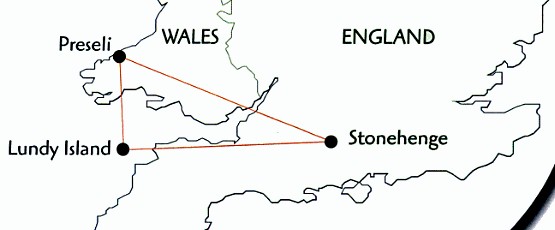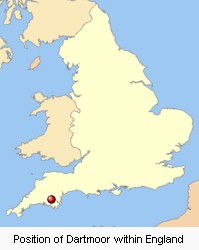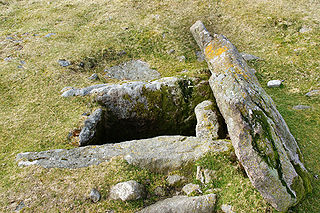8' 2" Giant grave on Lundy island
The
Mystery of Stone Circles - Paul Mason

Lundy
Island, from Lundy, Isle of Avalon by Mystic Realms - http://www.lundyisleofavalon.co.uk/lundy/index.htm
Giant's Graves on Lundy island
During harvest time in 1851 islanders on Lundy discovered two immense
granite coffins, one of them said to have been ten feet long the other
eight.
When these sarcophagi were opened, the excavators found the skeletons of
two eight feet tall humans, seven other skeletons
of normal stature and other assorted human bones. Either in the coffins
themselves or beside them, sources vary, were found some pale blue stone
beads and some fragments of pottery. The date attributed to the beads, and
also the graves, is anywhere from Roman times to the 14th century. The
beads were apparently sent to Bristol Museum but there seems to be no record
of what happened to the human remains.
http://genuki.cs.ncl.ac.uk/DEV/LundyIsland/LundyMurray1879.html
LUNDY ISLAND From A Handbook for Travellers in Devonshire (9th ed.),
London, J. Murray. (1879)
The island is about 3½ m. long, and very irregular in breadth, averaging
about ½ m. It contains nearly 3000 acres. The surface is undulating
table-land, rising to about 500 ft. at the lighthouse. There is only one safe
landing-place, at the S.E. end, where there is a little bay with good
anchorage. Until steamers came into play, "the difficulty of getting to
Lundy was only exceeded by the difficulty of getting away. A sudden shift of
wind has often kept visitors for weeks; and one amusing instance is on record
of a party composed of the incumbents of 5 or 6 parishes on the adjoining
coast, who had combined for a day's excursion and investigation of the wonders
of Lundy, being detained there over two Sundays, to the dismay of their
respective congregations." *
Lundy seems to have had a "primaeval" population: since flint flakes
and pottery have been found in and near the many small tumuli which dot the
surface.
A sepulchral kistvaen - a block of granite, raised on two upright slabs -
was found, a little below the surface, in 1851. A fragment of pottery
remained below, but there were no traces of bone.
...
http://www.archive.org/stream/coastsofdevonlun00pageuoft/coastsofdevonlun00pageuoft_djvu.txt
THE COASTS OF DEVON AND LUNDY ISLAND THEIR TOWNS, VILLAGES,
SCENERY, ANTIQUITIES AND LEGENDS
JOHN LLOYD WARDEN PAGE
AUTHOR OF 'AN EXPLORATION OF DARTMOOR AND ITS ANTIQUITIES,' 'AN EXPLORATION OF
EXMOOR AND THE HILL COUNTRY OF WEST SOMERSET,' 'THE
RIVERS OF DEVON, FROM SOURCE TO SEA,' 'OKEHAMPTON: ITS CASTLE,' ETC., ETC.
WITH MAP AND ILLUSTRATIONS
LONDON - HORACE COX - WINDSOR HOUSE, BREAM'S BUILDINGS, B.C. 1895
...
PART II. LUNDY ISLAND.
CHAPTER XIII. A GENERAL DESCRIPTION.
...
CHAPTER XIV. THE ISLAND KINGDOM.
...
Hubba Skeleton
A large area at the back of the farm is covered with outbuildings, not in the
best condition in fact, they look as though they had been put up with a view
to greater agricultural developments than have as yet made their appear-
ance and then neglected.
They are all, as is the Manor House itself, of modern date some, indeed,
erected within the last few years.
It was while some of these " improvements" were in progress that
the workmen made a curious discovery.
While digging foundations for the wall of the rickyard, they came upon a
pair of kistvaens, or stone coffins, built of granite, and each
covered with a large slab.
The larger grave was loft, in length, and provided with a lump or pillow of
granite, hollowed out for the reception of the head of a gigantic skeleton
which lay within. The feet rested on another block.
The smaller cist, which also contained a skeleton, was but 8ft. long, and
differed from the other in having no head or foot rest. Both were covered with
a pile of limpet shells.
Mr. Heaven was sent for, and the skeletons carefully measured.
The larger had a stature of 8ft. 2in.
Mr. Heaven was present the whole time, and not only saw the measurement
taken, but, as he himself told me, saw one of the men place the shin-bone
of the skeleton against his own, when it reached from his foot half-way up
his thigh, while the giant's jaw-bone covered not only his chin, but beard as
well.
The skeleton in the smaller cist, although that of a very tall person, was
thought little of beside that of the giant. Mr. Heaven, who has some knowledge
of anatomy, considered it to be that of a woman.
Close by seven other skeletons were discovered, but these were of ordinary
stature, and buried without stone coverings.
At the end of the line lay a great quantity of the bones of men, women, and
children, buried in one common grave.
Some glass and copper beads and one of gold were found with these bones, and a
few fragments of pottery. Some of these were preserved, and the bones were
then covered up.
As Mr. Chanter says, "it is most difficult to assign an era or to account
for this sepulture ; the remains of women and children precluding the idea of
its betokening the slain in battle, but rather the indiscriminate slaughter of
an entire population." Still, as he points out, this does not explain the
peculiar character and contents of the kistvaens.
These he refers to the Celtic period. But did the Celts produce such giants as
the pair interred in these stone coffins?
I fancy not.
Mr. Heaven exclaimed, when he saw the larger skeleton, " the bones of
Hubba the Dane !"
and the proportions are certainly rather Scandinavian than Celtic. Undoubtedly
it was the custom of the Danes to remove their more honoured dead, and Lundy
was "the nearest point to which the defeated army and ships could
retreat."
Dartmoor
It is interesting that there are graves like this in nearby Dartmoor:
Dartmoor kistvaens
- are burial tombs or cists
from the Neolithic
age, i.e. they are approximately 4,000 years old.[1]
Kistvaens
have been found in many places, including Dartmoor,
a 954 square kilometre (some 370 square miles) area of moorland
in south Devon,
England.
The box-like stone tombs were created when the ancient people of the area
lived in hut
circles. A feature that differentiates Dartmoor kistvaens from kistvaens
in other parts of the world is that about 94% of Dartmoor kistvaens have the
longer axis of the tomb oriented in a NW/SE direction.[1]
It appears that Dartmoor kistvaens were positioned in such a way that the
deceased were facing the sun.[2]

 Welcome to the Dartmoor National Park Authority
Welcome to the Dartmoor National Park Authority
The Dartmoor Kistvaens
Attempting to even try to explain burial tombs which are around 4,000 years
old is virtually impossible and full of modern-day conjectures and beliefs.
Clearly the very design of ancient tombs had some significance and meaning to
the prehistoric mind but trying to say exactly what is impossible.
...
So
to begin with what are these tombs called, generally they are referred to as cists
although on Dartmoor there is often mention of kistvaens or kists.
It is thought that the word kistvaen has derived from the Celtic cist
(chest) and maen (stone) aptly meaning 'stone chest' although how the
letter 'k' came to be used I know not.
The
accepted description of a 'typical' Dartmoor kist is that it comprises of a
four-sided stone chest with a covering slab and occasionally a paved floor.
They were constructed of stone, mostly granite, because presumably there was a
plentiful supply on the moor. The majority were dug into the sub-soil so
that the top edges of the side slabs were flush with the surface level. There
kists come in a large range of sizes which vary from one of the largest at Roundy
Park to the fairly small at Drizzlecombe. Although it is estimated
than an average sized kist would be about 1 - 1.5m long, 0.6m wide, and 0.6m
deep.
...
And of course not only Stonehenge, almost directly south, there is also
Carnac in Brittany:
Carnac
Carnac - (Breton:
Karnag) is a commune
beside the Gulf
of Morbihan on the south coast of Brittany
in the Morbihan
department
in north-western France.
Its inhabitants are called Carnacois. Carnac is renowned for the Carnac
stones one of the most extensive Neolithic menhir
collections in the world as well as its beaches,
which are popular with tourists.
Located on a narrow peninsula halfway between the medieval town Vannes
and the seaside resort Quiberon,
Carnac is split into two centres - Carnac-Ville and Carnac-Plage
(the beachfront). In total there are five beaches, including la Grande
Plage, and further to the east, Plage Men Dû and Beaumer.


Carnac is famous as the site of more than 3,000 prehistoric standing
stones. The stones were hewn from local rock
and erected by the pre-Celtic
people of Brittany.
Local tradition claims that the reason they stand in such perfectly straight
lines is that they are a Roman
legion turned to stone by Merlin
(Brittany has its own local versions of the Arthurian
cycle).
The Carnac stones were erected during the Neolithic
period which lasted from around 4500 BC
until 2000
BC. The precise date of the stones is difficult to ascertain as little
dateable material has been found beneath them, but the site's main phase of
activity is commonly attributed to c.
3300 BC. One interpretation of the site is that successive generations visited
the site to erect a stone in honour of their ancestors.
The Riddle of Prehistoric Britain - Comyns Beaumont
Bradshaw's hand-book to Brittany - John William C. Hughes, George Bradshaw
Plouharnel (Hotel: De Commerce)."At about 800 yards beyond this village, and on the left-hand side on the road to Erdeven, will be found
a group of three Dolmens, each approached by a gallery they were opened in
1850. The centre one contained only some broken celtae; in the second one was found, in the centre of the chamber, an earthen vase, containing fragments of bones, cinders, and charcoal,
a gold torque, and two gold bracelets, the extremes of which hook into each
other. This cyst had also an inner chamber, in which was found some bones and coarse pottery. The third chamber also contained some pieces of pottery, as also a large spherical vase, which, on being removed, fell to pieces.
The greater part of these are preserved in cases at the Hotel de Commerce, which is a really comfortable country inn, the proprietor of which is pleased to show them to visitors.




